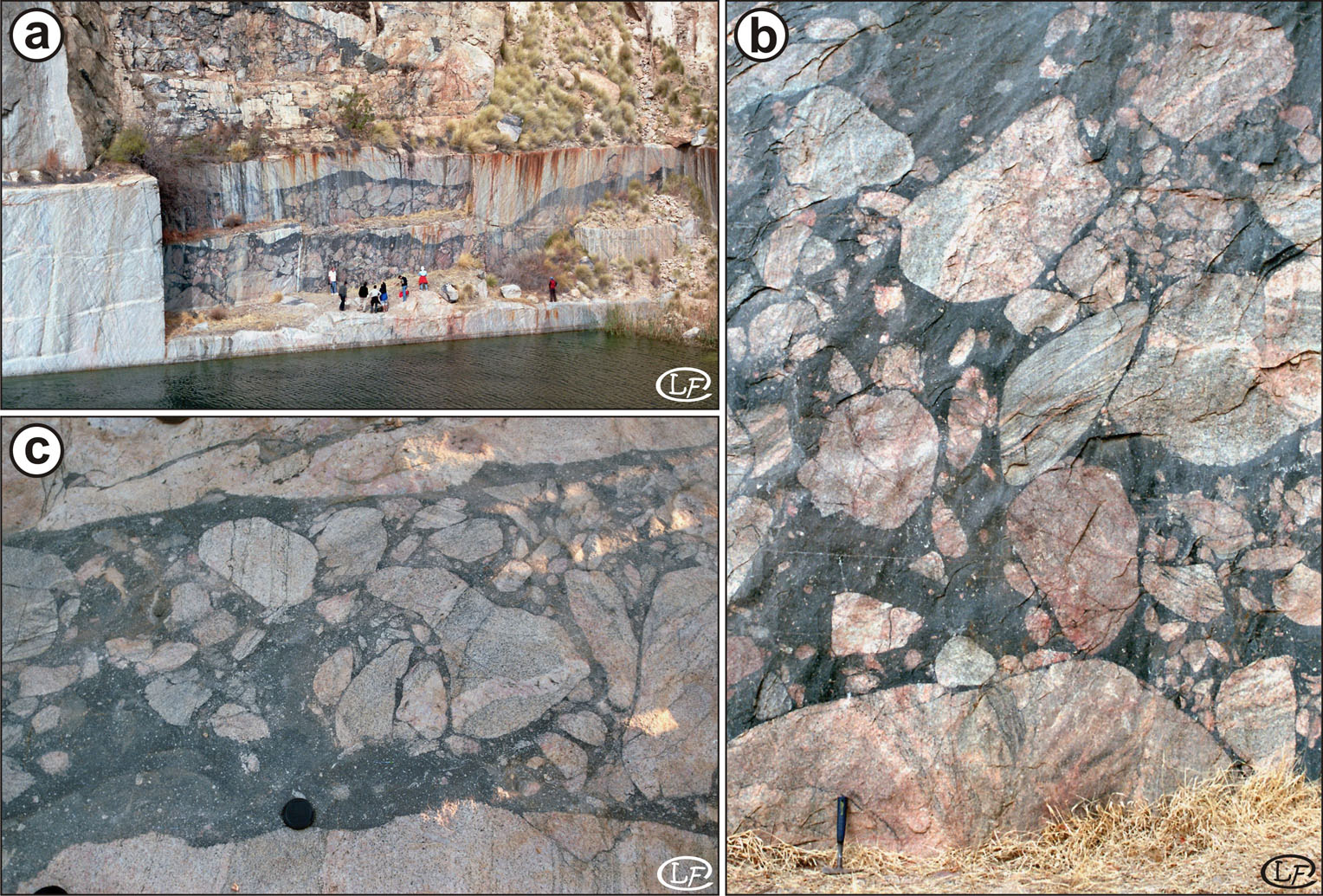Proximal impactites are subdivided into shocked rocks, impact breccias, and impact melt rocks.
1. Shocked rocks
Shocked rocks are defined as “non-brecciated rocks, which show unequivocal effects of shock metamorphism, exclusive of whole rock melting” (Stöffler and Grieve, 2007). Shocked rocks are further subclassified into “progressive stage of shock metamorphism” (Stöffler and Grieve, 2007). For each of the different types of lithologies, such as quartzofeldspathic, basaltic-gabbroic, sandstone, etc., the subclassification is somewhat different, as each rock type is modified (i.e., altered) differently at the same peak pressure. The so-called shatter cones fall in this group of "shocked rocks".
2. Impact breccias
According to Stöffler and Grieve (2007), impact breccias are subdivided into three subgroups, namely, monomict breccia, lithic breccia, and suevite. This subdivision is based on the degree of mixing of the different target lithologies and on the occurrence of melt particles (Stöffler and Grieve, 2007). Pseudotachylitic breccia is not included in the list of the different types of impact breccias, but it should be added to this list, as an additional subtype of impact breccia.
2.1. Monomict breccia: The monomict (impact) breccia is, according to Stöffler and Grieve (2007), “a cataclasite produced by impact and displaying weak or no shock metamorphism”. This definition is in fact not fully correct, as it is impossible in absence of evidences of shock metamorphism to differentiate a monomict breccia from a conventional cataclasite formed by tectonic. Monomict breccia occurs usually in the “(par)autochtonous floor of an impact crater” or as clasts/blocks “within polymict impact breccia” (Stöffler and Grieve, 2007).
2.2. Lithic breccia: The lithic (impact) breccia is a polymict impact breccia with clastic matrix containing mineral and lithic clasts, but lacking cogenetic impact melt particles (see Figure 1; Stöffler and Grieve, 2007). The different clasts are excavated from different regions of the target rock section, transported, mixed, and deposited inside or around the impact crater or injected, as dykes, into the target rocks (Stöffler and Grieve, 2007). In the rare case of single lithology target, a lithic breccia can be monomict.
2.3. Suevite: Suevite (or suevite breccia, or suevitic breccia)
is defined as a “polymict impact breccia with particulate matrix
containing lithic and mineral clasts in all stages of shock
metamorphism including cogenetic impact melt particles which are in
a glassy or crystallized state” (see Figure 2; Stöffler and Grieve,
2007). The name of suevite, originally used for impact breccias from
the Ries impact structure (Germany), have been generalized, and is
now used for the description of similar rocks occurring within or
outside of the crater rim, such as at the Bosumtwi impact crater. In
some impact structures, dykes of suevite are also reported (such as
at Bosumtwi; Ferrière et al., 2007). |
Navigation
Impact Cratering
Types of Impact Craters
Cratering Mechanics
Terrestrial Impactites
Proximal Impactites
Distal Impactites
Impact Metamorphism |

2.4. Pseudotachylitic breccia: Pseudotachylitic breccia (or
pseudotachylite, or pseudotachylite-like breccia, or impact
pseudotachylite) contains unshocked and shocked mineral and lithic
clasts in a fine-grained aphanitic (or crystalline) matrix (see
Figure 3). Clasts are both, rounded and angular, and range from
submicroscopic to pluri-meters in size. Typically pseudotachylitic
breccia occurs as irregular dike-like bodies, such as at Vredefort
(South Africa) or at Sudbury impact structure (Ontario, Canada).
Pseudotachylitic breccia is debated to be the result of shock
melting, friction melting, or decompression melting (for more
information, see, e.g., Reimold, 1995; French, 1998; Reimold and
Gibson, 2005). |
|

3. Impact melt rocks
Impact melt rock (or impact melt breccia) is a
“crystalline, semihyaline, or hyaline rock solidified from impact
melt and containing variable amounts of clastic debris of different
degree of shock metamorphism” (see Figure 4; Stöffler and Grieve,
2007). Impact melt rocks can be subdivided according to the content
of clasts (Stöffler and Grieve, 2007), namely, clast-rich,
clast-poor, and clast-free; or subdivided according to the degree of
crystallinity (French, 1998), namely, holohyaline (glassy),
hypocrystalline (mixture of glassy and crystalline), and
holocrystalline (completely crystalline). Impact melt rock occurs
generally within the crater, forming large bodies, sill-like bodies
or dike-like bodies penetrating the basement rocks (e.g., French,
1998). |
|
|